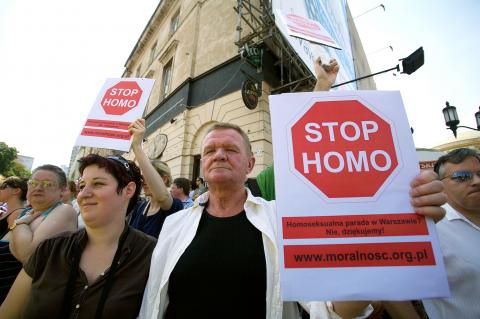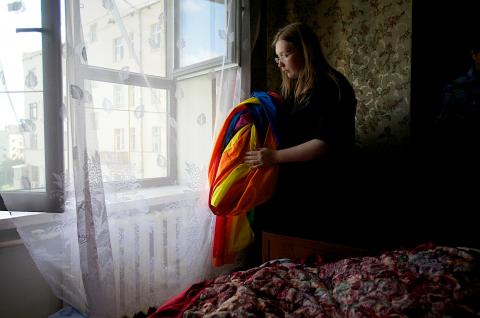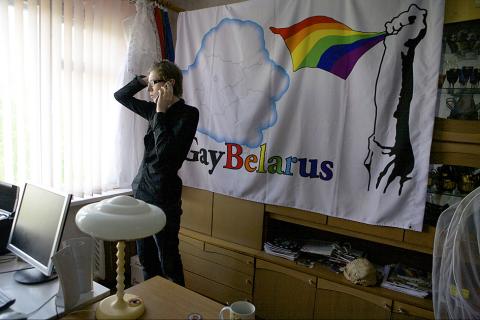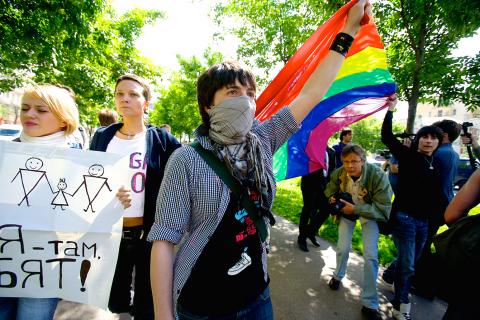Photography project Walk With Pride showcases the results of a year’s work exploring a spectrum of gay pride events around the world, from the exuberant Sydney Mardi Gras to banned parades in Belarus and Russia.
Taipei-based travel photographer Charles “Chad” Meacham and partner Sarah Baxter, a freelance writer, have traveled to 15 countries for the project, including Turkey, the Philippines, Croatia, Bulgaria and Israel. Walk With Pride will come full circle when Meacham photographs this year’s Taiwan Pride on Saturday. He was inspired to launch Walk With Pride after attending last year’s event, the biggest of its kind in Asia.
“I had never been to a pride parade before or really known anyone in the [gay] community, but for us it’s a very basic human right,” Meacham said. “I thought, ‘These things go on all over the world, so we can probably link them together to show what is going on right now, but in different cultures and in different communities.’”

Photo courtesy of Charles Meacham
The pride events covered by Meacham and Baxter vary dramatically. The Sydney Gay and Lesbian Mardi Gras, one of the largest pride events in the world, is a major source of tourism revenue for the city.
This year’s Slavic Pride Parade in Minsk and Moscow Pride, on the other hand, were both held despite bans by city authorities. Former Moscow mayor Yury Luzhkov, who once referred to gay pride parades as “satanic,” had prohibited Moscow Pride events since 2006. (Luzhkov was dismissed last month by Russian President Dmitry Medvedev.)
Russian gay rights activist and lawyer Nikolai Alekseev, the founder of Moscow Pride, says that projects like Walk With Pride are important because they not only publicize gay pride events, but also leave a record.

Photo courtesy of Charles Meacham
“I believe it is important that we leave a track of our actions so that in the future, others will see what we did. When I started with LGBT rights in 2000, I was looking at what happened in Russia [on the subject in the 1980s and 1990s],” Alekseev wrote in an e-mail. “There is no information available. Simply because no one documented anything.”
The atmosphere before the banned parades in Minsk and Moscow was “very cloak and dagger,” says Meacham, who accompanied organizers as they attended court hearings and held meetings to discuss the possibility of violence by anti-gay protesters. “Those are totally different kinds of [pride parades]. They’re not the ones where you’re out and about,” he said.
One of Meacham’s favorite photos shows gay activist Maria Yefremenkova in a quiet moment before Moscow Pride in May, holding a rainbow pride flag and looking out the window. In defiance of the city ban, 30 to 40 participants unfurled the flag and marched with it for a short distance.

Photo courtesy of Charles Meacham
“This was a moment where she’s reflecting. We’re right about to leave for the parade. We don’t know if there will be arrests or skinheads and she’s holding the flag and very quietly looking at it,” Meacham said.
During his year of covering pride events, Meacham has witnessed homophobia manifested differently across cultures.
“The struggle for most of the Taiwanese [gay] community is more of a legal fight, but if you go to Eastern Europe where homophobia is very ingrained and mixed with right-wing extremism, you are dealing with violence and skinheads,” he said.

Photo courtesy of Charles Meacham
Organizer Sergey Yenin was arrested and detained in Minsk after marching in the banned parade there in May. During the first pride parade held in Lithuania, which also took place in May, a crowd of about 1,000 anti-gay protesters outnumbered the 400 marchers. In Zagreb, Croatia in June, demonstrators made Nazi salutes. Other protesters at different events carried signs or banners with slogans like “Play in Hell” or “Stop Homo.”
In contrast, Meacham and Baxter were moved by the support shown for the first Istanbul Trans Pride parade in June, which was held in response to violence against transgender people.
“We thought it would be 15 to 20 people walking down the street and it was hundreds,” Meacham said.

Photo courtesy of Charles Meacham
“You really see how different communities are when they have pride events,” Baxter said. “Some places are so against it, they have all these nuts going around, it’s almost like they are scared of the whole thing. And other places are much more accepting even when it’s something like the first transgender pride [parade].”
The Walk With Pride project is self-funded and Meacham and Baxter have already spent US$15,000 to US$20,000 on expenses. Hearing about the impact of homophobia, including a recent string of suicides by gay teenagers and ongoing debate over the repeal of the “don’t ask, don’t tell” law in the US, spurs the couple on.
“Homophobia is everywhere. I don’t know why it’s still okay for a bunch of guys sitting around to say ‘you’re gay, that’s gay.’ You’ll watch a movie and there are jokes about gay people. It really stands out to me now,” said Meacham, who plans to revisit Belarus and Russia next year.

Photo courtesy of Charles meacham
Meacham hopes that his photographs will encourage people to take part in pride events and combat homophobia, regardless of sexual orientation.
“I think most people don’t know the situation and what goes on in a lot of countries because, honestly, I really didn’t,” he said. “I hope they see the photos and they understand this is an important issue in the world and it needs to change.”

Photo courtesy of Charles Meacham
INFORMATION
Details: Photos from the Walk With Pride project will be exhibited in cities around the world (including Taipei at a to-be-determined location) for the next International Day Against Homophobia and Transphobia (IDAHO) on May 17. For more information visit www.walkwithpridenow.com and www.dayagainsthomophobia.org
WHAT: Taiwan LGBT Pride (台灣同志遊行)
WHEN AND WHERE: The parade sets off on Saturday at 2pm from Ketagalan Boulevard (凱達格蘭大道), in front of the Presidential Office, and will proceed along Gongyuan (公園), Xiangyang (襄陽), Chongqing South (重慶南) and Hengyang (衡陽) roads into Ximending (西門町), before returning to Ketagalan Boulevard
HOW TO GET THERE: From NTU Hospital MRT Station (台大醫院捷運站) Exit 1, walk south along Gongyuan Road (公園路), or from Chiang Kai-shek Memorial Hall MRT Station (中正紀念堂捷運站) Exit 6, walk north along Zhongshan South Road (中山南路) to the assembly point
On the Net: twpride.net
Read Page 16 of Saturday’s edition of the Taipei Times for full coverage of Taiwan LGBT Pride

June 2 to June 8 Taiwan’s woodcutters believe that if they see even one speck of red in their cooked rice, no matter how small, an accident is going to happen. Peng Chin-tian (彭錦田) swears that this has proven to be true at every stop during his decades-long career in the logging industry. Along with mining, timber harvesting was once considered the most dangerous profession in Taiwan. Not only were mishaps common during all stages of processing, it was difficult to transport the injured to get medical treatment. Many died during the arduous journey. Peng recounts some of his accidents in

What does the Taiwan People’s Party (TPP) in the Huang Kuo-chang (黃國昌) era stand for? What sets it apart from their allies, the Chinese Nationalist Party (KMT)? With some shifts in tone and emphasis, the KMT’s stances have not changed significantly since the late 2000s and the era of former president Ma Ying-jeou (馬英九). The Democratic Progressive Party’s (DPP) current platform formed in the mid-2010s under the guidance of Tsai Ing-wen (蔡英文), and current President William Lai (賴清德) campaigned on continuity. Though their ideological stances may be a bit stale, they have the advantage of being broadly understood by the voters.

Artifacts found at archeological sites in France and Spain along the Bay of Biscay shoreline show that humans have been crafting tools from whale bones since more than 20,000 years ago, illustrating anew the resourcefulness of prehistoric people. The tools, primarily hunting implements such as projectile points, were fashioned from the bones of at least five species of large whales, the researchers said. Bones from sperm whales were the most abundant, followed by fin whales, gray whales, right or bowhead whales — two species indistinguishable with the analytical method used in the study — and blue whales. With seafaring capabilities by humans

In a high-rise office building in Taipei’s government district, the primary agency for maintaining links to Thailand’s 108 Yunnan villages — which are home to a population of around 200,000 descendants of the Chinese Nationalist Party (KMT) armies stranded in Thailand following the Chinese Civil War — is the Overseas Community Affairs Council (OCAC). Established in China in 1926, the OCAC was born of a mandate to support Chinese education, culture and economic development in far flung Chinese diaspora communities, which, especially in southeast Asia, had underwritten the military insurgencies against the Qing Dynasty that led to the founding of